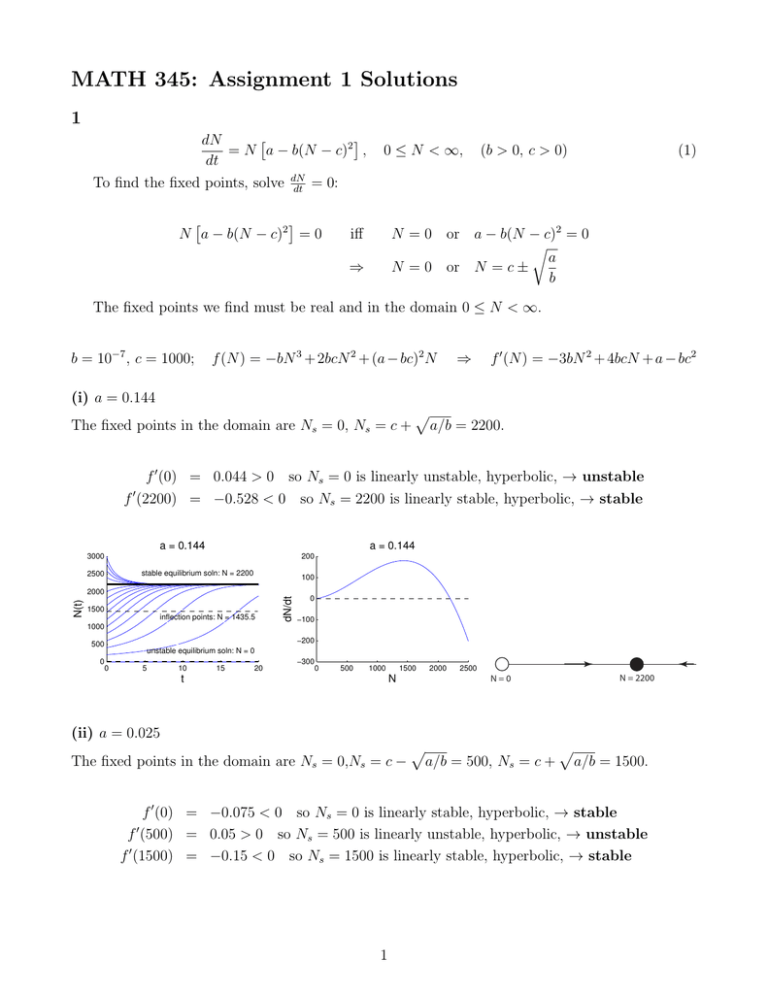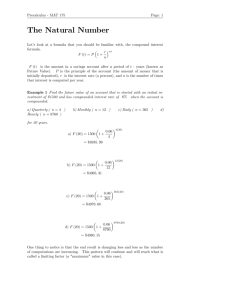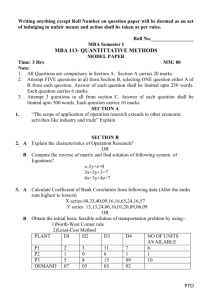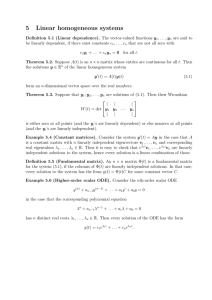MATH 345: Assignment 1 Solutions 1
advertisement

MATH 345: Assignment 1 Solutions 1 dN = N a − b(N − c)2 , dt To find the fixed points, solve dN = 0: dt N a − b(N − c)2 = 0 0 ≤ N < ∞, (b > 0, c > 0) (1) N = 0 or a − b(N − c)2 = 0 r a N = 0 or N = c ± b iff ⇒ The fixed points we find must be real and in the domain 0 ≤ N < ∞. b = 10−7 , c = 1000; f (N ) = −bN 3 + 2bcN 2 + (a − bc)2 N ⇒ f 0 (N ) = −3bN 2 + 4bcN + a − bc2 (i) a = 0.144 The fixed points in the domain are Ns = 0, Ns = c + p a/b = 2200. f 0 (0) = 0.044 > 0 so Ns = 0 is linearly unstable, hyperbolic, → unstable f 0 (2200) = −0.528 < 0 so Ns = 2200 is linearly stable, hyperbolic, → stable a = 0.144 a = 0.144 3000 200 stable equilibrium soln: N = 2200 2500 100 1500 inflection points: N = 1435.5 dN/dt N(t) 2000 0 −100 1000 −200 500 0 unstable equilibrium soln: N = 0 −300 0 5 10 15 20 0 500 1000 t 1500 N 2000 2500 N=0 N = 2200 (ii) a = 0.025 The fixed points in the domain are Ns = 0,Ns = c − p p a/b = 500, Ns = c + a/b = 1500. f 0 (0) = −0.075 < 0 so Ns = 0 is linearly stable, hyperbolic, → stable f 0 (500) = 0.05 > 0 so Ns = 500 is linearly unstable, hyperbolic, → unstable f 0 (1500) = −0.15 < 0 so Ns = 1500 is linearly stable, hyperbolic, → stable 1 a = 0.025 a = 0.025 3000 30 2500 20 stable equilibrium soln: N = 1500 dN/dt N(t) 2000 1500 1000 0 unstable equilibrium soln: N = 500 −10 500 0 10 stable equilibrium soln: N = 0 −20 0 5 10 15 20 0 500 t 1000 1500 N N=0 N = 500 (iii) a = −0.015 The only fixed point in the domain is Ns = 0. f 0 (0) = −0.115 < 0 so Ns = 0 is linearly stable, hyperbolic, → stable a = −0.015 a = −0.015 3000 5 2500 0 stable equilibrium soln: N = 0 −5 dN/dt N(t) 2000 1500 −10 1000 −15 500 −20 0 −25 0 5 10 t 15 20 0 200 400 600 N 2 800 1000 1200 N=0 N = 1500 2 a = 0.025 3000 2500 2500 2000 2000 N(t) N(t) a = 0.144 3000 1500 1000 1000 500 500 0 0 10 20 30 40 0 50 t a = −0.015 2500 2000 1500 1000 500 0 0 10 20 30 0 10 20 30 t 3000 N(t) 1500 40 50 t 3 40 50 3: Dimensionless form For (1) to make sense, a should have units of yr−1 , b should have units yr−1 individuals−2 , c should have units individuals. , τ = Bt where A has units of individuals, B has units of yr, with values chosen Let x = N A below. Substituting into (1) and using the Chain Rule, we get: A dx = Ax a − b(Ax − c)2 B dτ dx 2 A 2 = Bx a − bc ( x − 1) dτ c dx 2 A 2 = x Ba − Bbc ( x − 1) dτ c To get (2), choose A = c [individuals], dx = x r − (x − 1)2 , dτ B= 1 bc2 [yr] 0 ≤ x < ∞ with x = so that (1) becomes (2): N a , τ = bc2 t and r = 2 c bc (2) 4: Saddle-node bifurcation for (2) at xs = 1, rc1 = 0 f (x, r) = x r − (x − 1)2 = −x3 + 2x2 + (r − 1)x fx (x, r) = −3x2 + 4x + r − 1 fr (x, r) = x fxx (x, r) = −6x + 4 ⇒ ⇒ ⇒ ⇒ f (xs , rc1 ) = 0 verifies (SN1) fx (x∗ , rc1 ) = 0 verifies (SN2) fx (x∗ , rc1 ) = 1 6= 0 verifies (SN3) fx (x∗ , rc1 ) = −2 6= 0 verifies (SN4) (SN1) - (SN4) are all satisfied. Theorem from lectures implies there is a saddle-node bifurcation for (2) at xs = 1, rc1 = 0. 5: Another bifurcation for (2). Observe f (0, r) = 0 for any r: Possible transcritical or pitchfork birfurcation. Linearized stability of xs = 0: fx (0, r) = r − 1 xs = 0 is: i) linearly stable if r < 1, ii) non-hyperbolic if r = 1, or iii) linearly unstable if r > 1. Choose rc2 = 1. It cannot be a pitchfork bifurcation. (Why?). We know that TC1 and TC2 are satisfied. Check the remaining conditions: fxr (x, r) = 1 fxx (x, r) = −6x + 4 ⇒ ⇒ fxr (x∗ , rc2 ) = 1 6= 0 verifies (TC3) fxx (x∗ , rc1 ) = 4 6= 0 verifies (TC4) (TC1) - (TC4) are all satisfied. Theorem from lectures implies there is a transcritical bifurcation for (2) at xs = 0, rc2 = 1. 4 6: Critical value of a corresponding to r = rc2 = 1 From question 3, we had r = bca2 . If r = 1 ⇔ b = 10−7 , c = 1000 as in the XPP plots, then: a bc2 = 1 (i.e: a = bc2 ), so the critical value of if ac = bc2 = 0.1 For a = 0.144 > ac , there are three equilibrium solutions that are nonnegative. For a = 0.025 < ac , there are two equilibrium solutions that are nonnegative. Between a = 0.144 and a = 0.025, the stability of Ns = 0 has changed. This is consistent with a transcritical bifurcation occuring at ac = 0.1, where Ns = 0 changes stability and one of the other positive fixed points becomes a negative fixed point. (More on this in HW2). 7: Interpretations a is the maximum possible per capita growth rate. c is the population at which this maximum per capita growth rate is attained. (i) If the maximum growth rate is large enough (a > 0.1) there is no possibility of extinction, according to the model: any positive initial population N0 > 0 leads eventually to a positive population: √ lim N (t; N0 ) = 1000 + t→∞ 107 a (ii) For intermediate maximum growth rates (0 < a <√0.1), there is a threshold value of population below which leads to extinction: if 0 < N0 < 1000− 107 a, then eventually the population becomes extinct: lim N (t; N0 ) = 0 However, if N0 ≥ 1000 − √ t→∞ 107 a, the population does not become extinct. (iii) For negative maximum growth rates (a < 0) the population always becomes extinct. lim N (t; N0 ) = 0 for any N0 > 0 t→∞ This should not be surprising since the per capita growth rate is always negative. 5







